Table of Contents
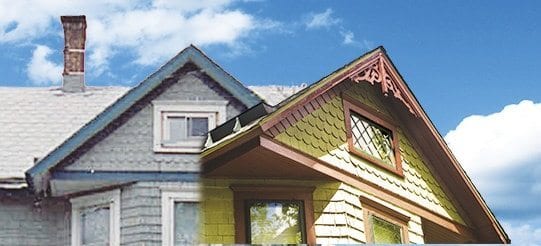

1. Seven ways to NOT "re-muddle" a historic home
By Marni Jameson Special to The Denver Post POSTED: 05/17/2014 12:01:00 AM- Keeping the period pocket doors, original floors, walls, windows and radiator, while adding fresh details and colors, helped this renovation succeed.
"Every time I move into another home to stage — and I'm in my fourth in three years — I play a game of "If This Were Mine."
- If this house were mine, I would rip this out and put that in, knock this down and stick that up. It's an affliction.

Fortunately, because I don't own these places, I am all talk and no caulk. All nail and no hammer. Because I live under a restraining order that comes with non-homeownership, these homes have been spared clueless improvements that could have actually harmed them, particularly the older homes.
- My last three houses have been historic: a 130-year-old Folk Farmhouse, a 100-year-old Southern Plantation-style home, and currently, an 85-year-old Spanish Mediterranean. Though different in character, what each has in common is a past — and that, I have come to understand, is worth preserving.
- "They tear out important and valuable architectural elements and replace them with off-the-shelf items from the local big-box store all in the name of improvement."
- The worker, who didn't know what I do for a pseudo living, was chatting in passing while I packed my lunch for work, but I was listening closely and thinking, "Holy Mary, that could be me!"
We soon sounded like historic-home evangelists in need of an intervention. "People don't do the wrong thing on purpose," said Curtis. "They do the wrong thing because they aren't educated."
"Well, let's fix that," I said.
- "The biggest mistake people make when improving an old home is they try to do what's hot right now," said Curtis. "But what's hot right now won't be hot in 10 years. What will always be hot, and will maintain the home's value, is keeping with the era of the home."
Her advice — tear out almost nothing, restore what's there — is not only better for the home's value, it's easier on the wallet.
On her short list of what she would add or replace in an older home are these modern conveniences:
- Walk-in closets "but added in a way where they don't take away from the character of the home";
- updated heating, cooling systems, and plumbing systems, "so homes are comfortable, safe and more energy-efficient,"
- and new appliances that weren't invented when the house was built.
Beyond that, here are some of her tips for updating an older home without messing it up:
1 Keep the cabinets.
When Curtis sees people pull out solid wood cabinets to put in new ones made of melamine, or MDF (medium-density fiberboard), she cringes. "These manmade materials were not made for years of wear and tear. They don't handle moisture well. The laminate pulls away, and the pulls come off." Instead, strip and refinish the wood. It looks better, lasts longer and will save money.2 Refinish the tubs and sinks.
To give an old porcelain bathtub a new coat costs about $400. A new tub can run more than $1,000, not including demo and installation, said Curtis, who is especially horrified when homeowners swap an old porcelain tub for a fiberglass Jacuzzi.3 Save wood floors.
Covering old wood floors with cheaper inferior tiles or carpet is a common crime. Even worse is removing them. "I have never replaced a wood floor in my life," said Curtis. "I've worked with floors that were burnt, flooded and covered in pet stains. It is always cheaper and more authentic to refinish existing floors and patch sections where needed." You can always get the patch to match.4 Clean old tile.
Half the reason old tile floors or other tile surfaces look worn out is because they are filthy. Don't tear them out until you've given them a good cleaning, said Curtis.5 Make counters authentic.
Don't use products that weren't available when the house was built. That means nothing manmade, like laminate or Corian, and nothing modern, like glass tiles. Go for wood counters, like butcher block, or classic marble, and occasionally granite. Ceramic tiles work in homes built after 1930.6 Keep the walls up.
Open floor plans are a trend, but they don't belong in old houses, said Curtis. "After a couple years of living in an open floor plan, people don't want it anymore." Before knocking out a wall (which Curtis would rarely do) live in the house for six months. "Get into the groove of the home and see how it lives."7 Repair, don't replace, windows.
They are important to the home's historic value. Old windows leak and are drafty because they haven't been properly maintained. Have them repaired and weatherstripped so they're efficient and work. Adding historically accurate storm windows outside can boost efficiency. The same for original doors. Leave them.Syndicated columnist Marni Jameson is the author of "House of Havoc" and "The House Always Wins" (Da Capo Press). Contact her through marnijameson.com.
2. Remuddling Medley

We've had such a symphony of remuddling letters come our way of late,we thought we'd orchestrate them into a set, so to speak, for this issue's Old-House Living feature. The idea is not so offbeat. Old-House Living is typically a tale about the human impact of the restoration process, and what happens to the exterior of an old house, restoration or not, affects all who see it. As long-time OHJ readers know, remuddling is defined as misguided remodeling-that is, an alteration that is insensitive to the architecture or character of the house. Remuddling is presented as a negative education, but it is also meant to be a bit of fun. This back-of-the-book department debuted nearly two decades ago in October 1981, and ever since then it has been the most popular and well-known page in OHJ. In fact, the word remuddling has entered common use.
You get the picture. As ever, if you are inclined to submit a picture for Remuddling, please send original color prints-no newspaper clippings-and try to include a photo of a similar, but unremuddled building. If we use your photos, we'll conduct you a melodious $100.
MATERIAL DIFFERENCES

"This home is in the lake area of Southeastern Wisconsin," says Dave Abresch of Menowonee Falls. "I'm not sure of the material and style, but it may be built of local limestone." We can't say for sure either, but the way the horizontal siding meets stonework is unique to say the least.
MULTIPLE PERSONALITIES

Philip Nord of Bryn Mawr, Penn. sent in this photo with the terse comment that he "Thought this might be of interest." That's putting it mildly. While it's hard to divine what this house looked like the day it was built, chances are it didn't have three different configurations of windows on the first floor, two on the second floor, and three on the third floor-or a third floor at all.
DEAR DEPARTED

"Here are photos of a beautiful brick Queen Anne buried by a mortuary," writes Mona Rummel, who lives in Eugene, Ore. "I couldn't help noting the We Care sign nearby." There's no question that building upgrades can be a big undertaking, but they shouldn't risk being a grave mistake.
EXTRA CHEESEY?
 Ordinarily, adaptive re-use is to be applauded as an alternative to bringing in the bulldozers, but this Foursquare in Hanover, Penn. may be of a different order. "I'm not sure how long it has been this way, but I remember seeing it as a pizza parlor for at least 15 years," says Theresa Bethune of Westminister, Md.
Ordinarily, adaptive re-use is to be applauded as an alternative to bringing in the bulldozers, but this Foursquare in Hanover, Penn. may be of a different order. "I'm not sure how long it has been this way, but I remember seeing it as a pizza parlor for at least 15 years," says Theresa Bethune of Westminister, Md.BEING IGNORED IS BLISS

"Ironically, the house on the left was a semiderelict for many years before an enlightened family who cared about the home rehabilitated it," says August Gene Grulich of Tacoma, Wash. "Most of the features remained intact but covered with dull gray peeling paint. It's a case of what I call `preservation by neglect.'" Its companion to the right, on the other hand, appears to have fewer details today, despite some recent attention.
RAISING THE ROOF
 "I enclose prints I took on a side trip to Fulton, Missouri, known for Winston Churchill's famous Iron Curtain speech," writes Ed Weilbacher of Waterloo, Ill. "The town has a wonderful collection of historic homes, and we marvel at the energy that many people put into a proper restoration. On the other hand, it pains us to see people spend good money to devalue their property." His photos show a gable roof being erected over a mansard roof. Indeed, roofs help define the form and style of a house, and when an entire roof is altered, it's bound to change the house.
"I enclose prints I took on a side trip to Fulton, Missouri, known for Winston Churchill's famous Iron Curtain speech," writes Ed Weilbacher of Waterloo, Ill. "The town has a wonderful collection of historic homes, and we marvel at the energy that many people put into a proper restoration. On the other hand, it pains us to see people spend good money to devalue their property." His photos show a gable roof being erected over a mansard roof. Indeed, roofs help define the form and style of a house, and when an entire roof is altered, it's bound to change the house.OLDHOUSEGUY BLOG
3. CASE STUDY
Old House Restoration Or Remuddling?
April 24, 2012 by 1 Comment
The news papers said this is an old house restoration. Obviously they have no idea what they were writing about. This house received a Restoration Award by the Freehold NJ Historic Preservation Commission. A board of supposedly “qualified” people issued this award. Let’s look a bit further and see what a mess was created.
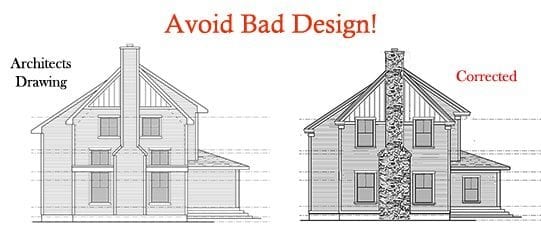
What is an old house restoration?
A definition for restoration is:
- The return of something to a former owner, place, or condition.
- The process of repairing or renovating a building, work of art, etc., in order to restore it to its original condition.
What is remuddling?
Remuddling is when the original character and integrity of a house is lost in the renovation process. Misguided improvements are made out of context and are insensitive to the character of the house.
See This Beautiful 1890’S House.
A beautiful late Queen Anne house before it was remuddled.
They state that this is an old house restoration. Sadly this house was remuddled and this is how it appears today.
Old House Restoration gone bad. The integrity of this house has been vandalized by the owner who is an architect.
During the process everything historic such as millwork, doors, hardware, etc. were removed and sadly discarded into a dumpster. What a crime to the house and the environment!
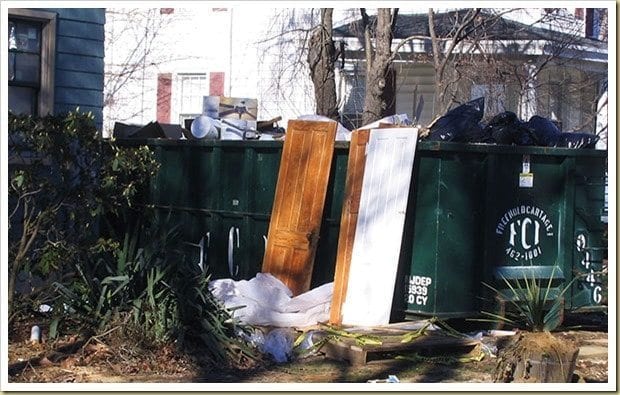 |
| old house restoration puts history in the dumpster |
The homeowner put history in the dumpster and the Historic Preservation Commission gave them an award.Before this old house restoration the house was well kept and had great architectural integrity. It is sad that the homeowner couldn’t leave the house alone. It had survived over 100 years flaunting it’s historic character to passers by until now.
To the average person with the untrained eye, this new plastic siding is shinny and some will see it as an improvement. Look at the before and after photos above again and let me explain the changes that should have not been done.
Although the house cannot be considered ugly as it stands today, it no longer retains its inherent good architectural design. Part of the porch is enclosed and the house is now covered with unhealthy plastic siding.
The facade of the house features three different styles of windows – Six-over-six, six-over-one, and four-over-one. Two sets of windows are rectangular and one set contains square window panes. The goal seemed to have been the mish-mash look of a McMansion – not to mention the homeowner is an architect who you would think would have some knowledge of what an old house restoration is! The architect is evidently more accustomed to McMansion design.
Definition of a McMansion from Wikipedia:
- …mix multiple architectural styles and elements
- …multiple roof lines, unnecessarily complicated massing
- …producing a displeasingly jumbled appearance.
- The builder may have attempted to achieve expensive effects with cheap materials, skimped on details,or hidden defects with cladding
- …Sold to “parvenu” – those having new money but lack the necessary refinement. The definition of parvenu on Wikipedia references Molly Brown survivor of the Titanic – who went from rags to riches over night. (See the movie “The Unsinkable Molly Brown”starring Debbie Reynolds).
Obviously, this house was not designed nor meant to feature six-over-one or four-over-one windows. One-over-one windows would undoubtedly work much better. Scroll up and notice the simple elegance of the windows on the original house.
Also notice that the trim is in a tan color which works well with the teal blue. But why is the balustrade on the roof and the hand rail at the steps white and not tan? These elements should match. Were they an after-thought? Is this an example of this owner/architects work?
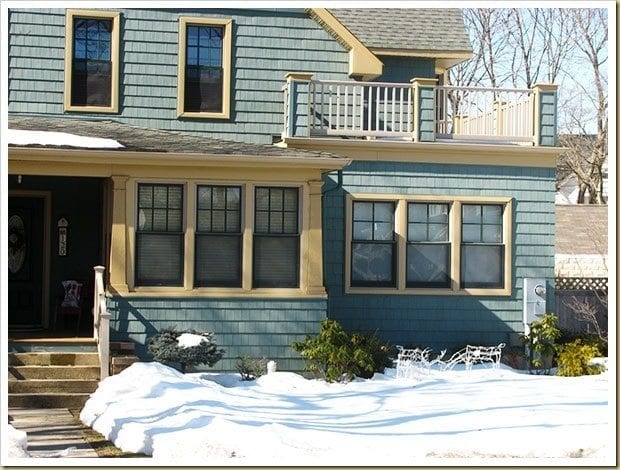 |
| old house restoration with bad replacement windows |
This house should have matching windows. Now there are rectangular and square window panes.
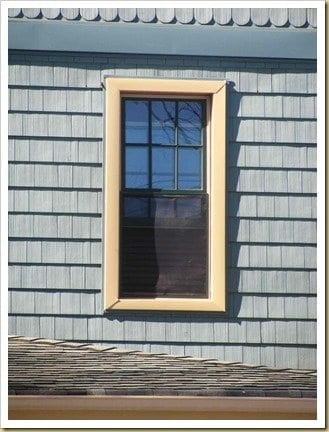 |
| old house restoration disaster with picture framed windows |
The window could not be designed any worse. Never ever use a picture framed window.
Notice the windows are “picture framed”. This is a window frame WITHOUT a sill at the bottom or a drip cap at the top.
It therefore looks just like a picture frame with mitered joints at all four corners which allow easy infiltration of water. (Water damage will not be noticed under the vinyl until it gets bad enough to be see indoors.)
There is no to sill provide a base. Your mind interprets the sill as a support base. Now all you have the appearance of a hole in the siding of the house.
The sill would allow water to run off and away from the building. A drip cap above the window casing would also deflect water. That will not happen here for these important feature are missing. Never picture-frame a window!
There is a lot to understand about good and bad window design and why this design is important which cannot properly be explained here. Click here to better understand window design.
The Gable
There are fish scale shingles in the gable. When using a secondary siding material such as fish scale shingles, there needs to be an architectural separation between the two where the siding changes. On the original house this would work well. By adding a belt course or band at the base of the gable, this area would then be neatly separated from the lower portions of the house.However on the remuddled house, the roof on the right side of the gable extends lower. The band or belt course installed extends from the lower corner of the gable on the left, to a random area on the right side not an opposite end of the roof. The architecture is not there to visually connect or create a breaking point there for a separation. The fish scale shingles seem out of place and a sense of balance is lost.
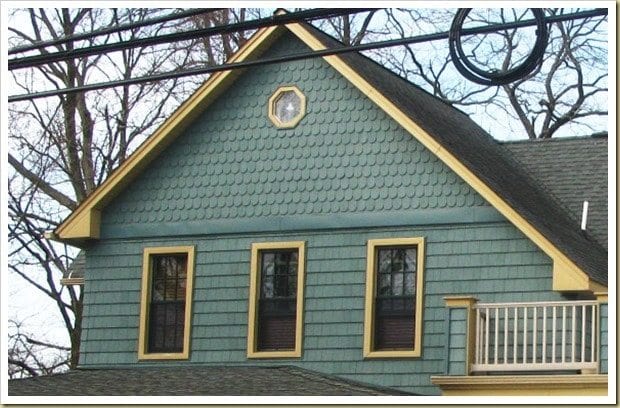 |
| old house restoration gone wrong with fish scale shingles |
If the roof did not slope down farther on the right, the horizontal band separating the fish scale shingles from the square shingles below would look fine. This was not done. Can you see and feel the disharmony?
It is really sad as to what was has been done to this house. All traces of its historic integrity have been blatantly destroyed. But the sage gets worse.
Old House Restoration Award Is Presented.
To top it all off, the Preservation Commission presented the homeowners with a RESTORATION AWARD (go back to the top for definition of Restoration). A Preservation Commission is viewed as an authority on preserving the character of old homes and although preservation cannot be enforced, it should be promoted and understood – at least a little if you are a member.The homeowner was awarded for the desecration of history – not an old house restoration. The HPC is not only setting a very poor example for others to follow, they are encouraging other homeowners to do the same. One of the purposes for having a Preservation Commission is to educate and set an example. Awards were granted to two homes, the other awarded home was very much deserving. Here is a link to the news article – preservation awards. It’s funny in a sad way.
The article really shows that the architect-homeowner, and the councilman Marc LeVine on the Historic Preservation Commission have no clue about an old house restoration or what they are talking about. It’s just political garbage.
The important thing to keep in mind is just because your town has a Preservation Commission does not mean that your dwindling historic resources are protected(actually I can write a book about this). A false sense of security provided by a Preservation Commission is more dangerous than having none at all. Homeowners and commissions must understand that they are stewards for historic buildings.
Also, there is a big difference between an architect and a preservation architect as you can see in this example. Many architects, although they may love old buildings, should stay far away from them and leave them to a architect specialized in preservation.
Would you take your 90 year old grandmother with a heart condition to a General Practitioner or a Heart Specialist?

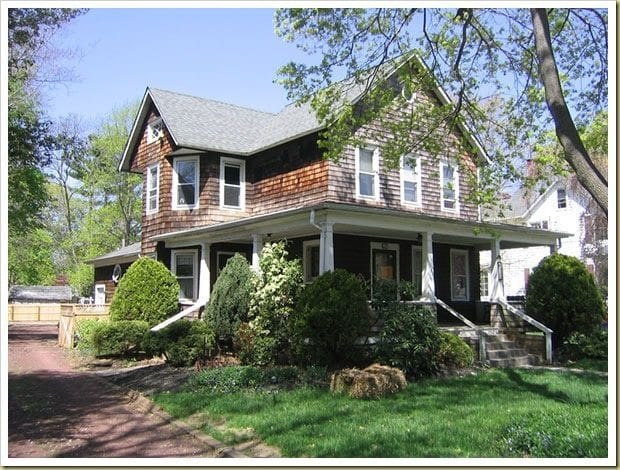
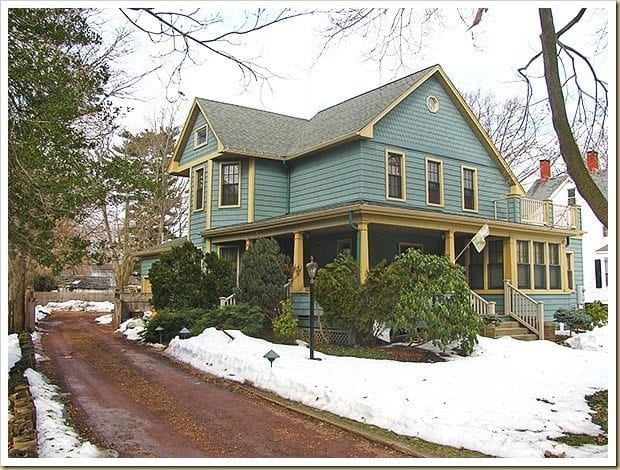
No comments:
Post a Comment